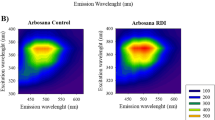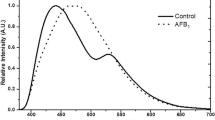Abstract
The Aflatoxin B1 (AFB1) contamination in peanut oil is harmful and widespread. In this study, a laser induced fluorescence spectroscopy (LIF) system was developed for rapid and non-invasive screening of four varieties of peanut oils contaminated with different levels of AFB1. Discriminant analysis was conducted to classify the four varieties of peanut oils into acceptable (AFB1 < 20 μg kg−1) and contaminated (AFB1 ≥ 20 μg kg−1) levels. The results of single-step modelling, which directly classify the whole 540 peanut oils into acceptable and contaminated levels, could achieve an accuracy of 95% and 93% for calibration and validation sets respectively. Considering the fluorescence spectra could easily be influenced by the difference of physicochemical properties of different varieties of peanut oils, two-steps modelling method was conducted. In the first step, the total 540 peanut oils were classified into four varieties with all accuracy of 100% based on 600–800 nm, by using LDA algorithm. In the second step, the AFB1 contamination levels of each variety were discriminated. The classification accuracy was increased by at least 5% by conducting two-steps modelling. The results of quantitative analysis showed that for single variety, PLSR based on 400–600 nm could achieve accurate quantitative prediction. The feasibility of LIF technique for the rapid and nondestructive detection of AFB1 contamination in different varieties of edible oils was proved in this study. Further research will focus on the detection of naturally infected oils.




Similar content being viewed by others
References
Index Mundi, Agricultural production, supply, and distribution (2019). Available at https://www.indexmundi.com/agriculture. Accessed 2 Oct 2020
R. Asis, D.L. Barrionuevo, L.M. Giorda, M.L. Nores, M.A. Aldao, Aflatoxin production in six peanut (arachis hypogaea L.) genotypes infected with Aspergillus flavus and Aspergillus parasiticus, isolated from peanut production areas of Cordoba, Argentina. J. Agric. Food Chem. 53(23), 9274–9280 (2005)
N. Qi, H. Yu, C. Yang, X. Gong, Y. Zhu, Aflatoxin B1 in peanut oil from western Guangdong, China, during 2016–2017. Food Addit. Contam. Part B Surveill. 12(4), 1–7 (2018)
R. Bhat, K.R.N. Reddy, Challenges and issues concerning mycotoxins contamination in oil seeds and their edible oils: updates from last decade. Food Chem. 215, 425–437 (2017)
M. Mahfuz, M.A. Gazi, M. Hossain, M.R. Islam, S.M. Fahim, T. Ahmed, General and advanced methods for the detection and measurement of aflatoxins and aflatoxin metabolites: a review. Toxin Rev. 1, 1–15 (2018)
B. Liu, Y. Hsu, C. Lu, F. Yu, Detecting aflatoxin B1 in foods and feeds by using sensitive rapid enzyme-linked immunosorbent assay and gold nanoparticle immunochromatographic strip. Food Control 30(1), 184–189 (2013)
I.Y. Rustom, Aflatoxin in food and feed: occurrence, legislation and inactivation by physical methods. Food Chem. 59(1), 57–67 (1997)
G.S. Shephard, Aflatoxin analysis at the beginning of the twenty-first century. Anal. Bioanal. Chem. 395(5), 1215–1224 (2009)
Q. Wu, L. Xie, H. Xu, Determination of toxigenic fungi and aflatoxins in nuts and dried fruits using imaging and spectroscopic techniques. Food Chem. 252, 228–242 (2018)
D. Bartolic, M. Stankovic, D. Mutavdžic, S. Stankovic, D. Jovanovic, K. Radotic, Multivariate curve resolution - alternate least square analysis of excitation-emission matrices for maize flour contaminated with Aflatoxin B1. J. Fluoresc. 28(3), 729–733 (2018)
F. Xing, H. Yao, Z. Hruska, R. Kincaid, Y. Liu, Detecting peanuts inoculated with toxigenic and atoxienic Aspergillus flavus strains with fluorescence hyperspectral imagery. Proc. SPIE 10217, 1021701–1021711 (2017)
W.L. Chen, D. Xing, W.G. Chen, Rapid detection of Aspergillus flavus contamination in peanut with novel delayed luminescence spectra. Photochem. Photobiol. 81(6), 1361–1365 (2010)
H. Kalkan, P. Beriat, Y. Yardimci, T.C. Pearson, Detection of contaminated hazelnuts and ground red chili pepper flakes by multispectral imaging. Comput. Electron. Agric. 77(1), 28–34 (2011)
S.J. Paghaleh, H.R. Askari, S.M. Marashi, M. Rahimi, A.R. Bahrampour, A method for the measurement of in line pistachio aflatoxin concentration based on the laser induced fluorescence spectroscopy. J. Lumin. 161, 135–141 (2015)
Y. Li, S. Chen, H. Chen, P. Guo, T. Li, Q. Xu, Effect of thermal oxidation on detection of adulteration at low concentrations in extra virgin olive oil: study based on laser-induced fluorescence spectroscopy combined with KPCA–LDA. Food Chem. 309, 125669 (2020)
T. Mu, S. Chen, Y. Zhang, H. Chen, P. Guo, F. Meng, Portable detection and quantification of olive oil adulteration by 473-nm laser-induced fluorescence. Food Anal. Methods 9(1), 275–279 (2016)
A. Bendini, L. Cerretani, F.D. Virgilio, P. Belloni, M. Bonolicarbognin, G. Lercker, Preliminary evaluation of the application of the FTIR spectroscopy to control the geographic origin and quality of virgin olive oils. J. Food Qual. 30(4), 424–437 (2007)
G. Dobson, Spectroscopy and spectrometry of lipids — part 1. Eur. J. Lipid Sci. Technol. 103, 815–840 (2001)
K. Rajer-Kandč, J. Zupan, N. Majcen, Separation of data on the training and test set for modelling: a case study for modelling of five colour properties of a white pigment. Chemom. Intell. Lab. Syst. 65(2), 221–229 (2003)
C. Lau, C. Chan, F. Chau, D.K. Mok, Rapid analysis of Radix puerariae by near-infrared spectroscopy. J. Chromatogr. A 1216(11), 2130–2135 (2009)
X. Niu, Z. Zhao, K. Jia, X. Li, A feasibility study on quantitative analysis of glucose and fructose in lotus root powder by FT-NIR spectroscopy and chemometrics. Food Chem. 133(2), 592–597 (2012)
O.E. Adedipe, S.D. Johanningsmeier, V.D. Truong, G.C. Yencho, Development and validation of a near-infrared spectroscopy method for the prediction of acrylamide content in french-fried potato. J. Agric. Food Chem. 64(8), 1850–1860 (2016)
A. Tarín, M.G. Rosell, X. Guardino, Use of high-performance liquid chromatography to assess airborne mycotoxins: aflatoxins and ochratoxin A. J. Chromatogr. A 1047(2), 235–240 (2004)
Y. Wang, T. Chai, G. Lu, C. Quan, H. Duan, M. Yao, B. Zucker, G. Schlenker, Simultaneous detection of airborne Aflatoxin, Ochratoxin and Zearalenone in a poultry house by immunoaffinity clean-up and high-performance liquid chromatography. Environ. Res. 107(2), 139–144 (2008)
E. Sikorska, A. Romaniuk, I. Khmelinskii, R. Herance, J.L. Bourdelande, M. Sikorski, J. Koziol, Characterization of edible oils using total luminescence spectroscopy. J. Fluoresc. 14(1), 25–35 (2004)
J.D. Manzano, A.M. La Pena, I.D. Meras, Front-face fluorescence combined with second-order multiway classification, based on polyphenol and chlorophyll compounds, for virgin olive oil monitoring under different Photo- and thermal-oxidation procedures. Food Anal. Methods 12(6), 1399–1411 (2019)
H. Ali, M. Saleem, M.R. Anser, S. Khan, R. Ullah, M. Bilal, Validation of fluorescence spectroscopy to detect adulteration of edible oil in extra virgin olive oil (EVOO) by applying chemometrics. Appl. Spectrosc. 72(9), 1371–1379 (2018)
N. Dupuy, Y.L. Dreau, D. Ollivier, J. Artaud, C. Pinatel, J. Kister, Origin of French virgin olive oil registered designation of origins predicted by chemometric analysis of synchronous excitation - emission fluorescence spectra. J. Agric. Food Chem. 53(24), 9361–9368 (2005)
A.L. Farsaie, W.F. Mcclure, R.J. Monroe, Development of indices for sorting Iranian pistachio nuts according to fluorescence. J. Food Sci. 43(5), 1550–1552 (1978)
J. Cao, C. Li, R. Liu, X. Liu, Y. Fan, Z. Deng, Combined application of fluorescence spectroscopy and chemometrics analysis in oxidative deterioration of edible oils. Food Anal. Methods 10(3), 649–658 (2017)
L. Lunadei, L. Ruizgarcia, L. Bodria, R. Guidetti, Image-based screening for the identification of bright greenish yellow fluorescence on pistachio nuts and cashews. Food Bioprocess Technol. 6(5), 1261–1268 (2013)
F. Tao, H. Yao, Z. Hruska, L.W. Burger, K. Rajasekaran, D. Bhatnagar, Recent development of optical methods in rapid and non-destructive detection of aflatoxin and fungal contamination in agricultural products. Trends Anal. Chem. 100, 65–81 (2018)
Q. Wu, H. Xu, Design and development of an on-line fluorescence spectroscopy system for detection of aflatoxin in pistachio nuts. Postharvest Biol. Technol. 159, 111016 (2020)
F. Guimet, J. Ferre, R. Boque, Rapid detection of olive-pomace oil adulteration in extra virgin olive oils from the protected denomination of origin “siurana” using excitation-emission fluorescence spectroscopy and three-way methods of analysis. Anal. Chim. Acta 544, 143–152 (2005)
Q. Wu, J. Xu, H. Xu, Discrimination of aflatoxin B1 contaminated pistachio kernels using laser induced fluorescence spectroscopy. Biosys. Eng. 179, 22–34 (2019)
C. Chang, D.A. Laird, M.J. Mausbach, C.R. Hurburgh, Near-infrared reflectance spectroscopy-principal components regression analyses of soil properties. Soil Sci. Soc. Am. J. 65(2), 480–490 (2001)
Funding
The authors appreciate the support provided by National Key Research and Development Program of China (2020YFE0200200), National Natural Science Foundation of China (31772061), Youth Science Fund of Jiangsu Province (SBK2020042843), Jiangsu Agriculture Science and Technology Innovation Fund (CX (19)2001).
Author information
Authors and Affiliations
Corresponding authors
Ethics declarations
Conflict of interest
All the authors declare that they have no conflict of interest.
Ethical approval
This article does not contain any studies with human participants or animals performed by any of the authors.
Informed consent
Not applicable in this study.
Additional information
Publisher's Note
Springer Nature remains neutral with regard to jurisdictional claims in published maps and institutional affiliations.
Rights and permissions
About this article
Cite this article
Chen, M., He, X., Pang, Y. et al. Laser induced fluorescence spectroscopy for detection of Aflatoxin B1 contamination in peanut oil. Food Measure 15, 2231–2239 (2021). https://doi.org/10.1007/s11694-021-00821-0
Received:
Accepted:
Published:
Issue Date:
DOI: https://doi.org/10.1007/s11694-021-00821-0




